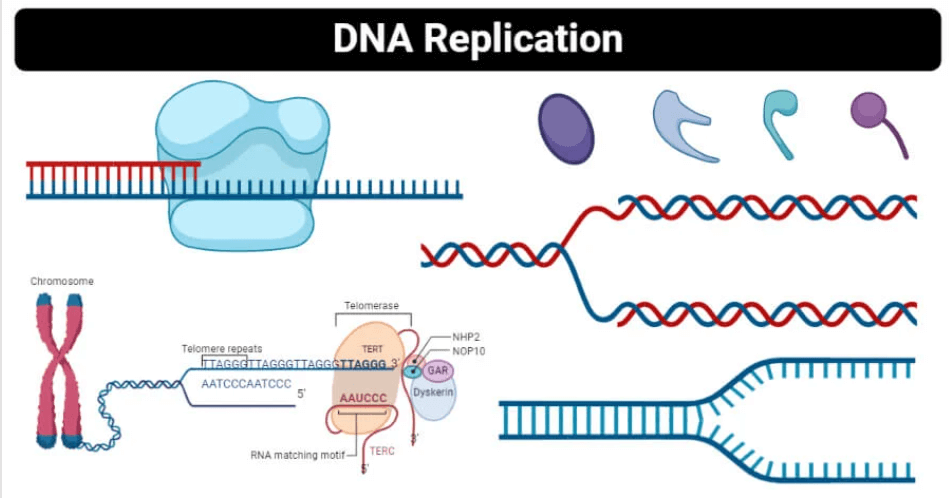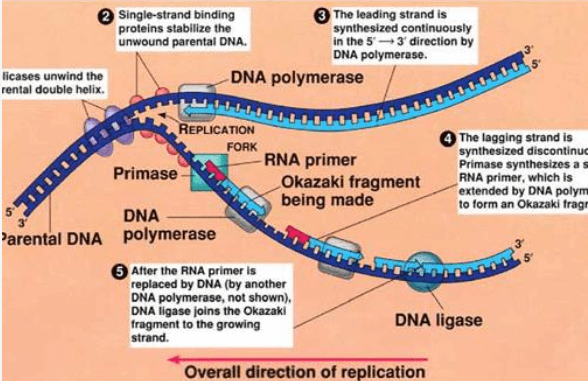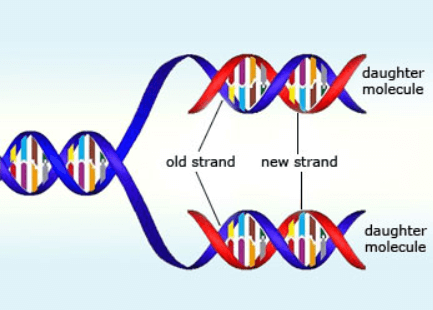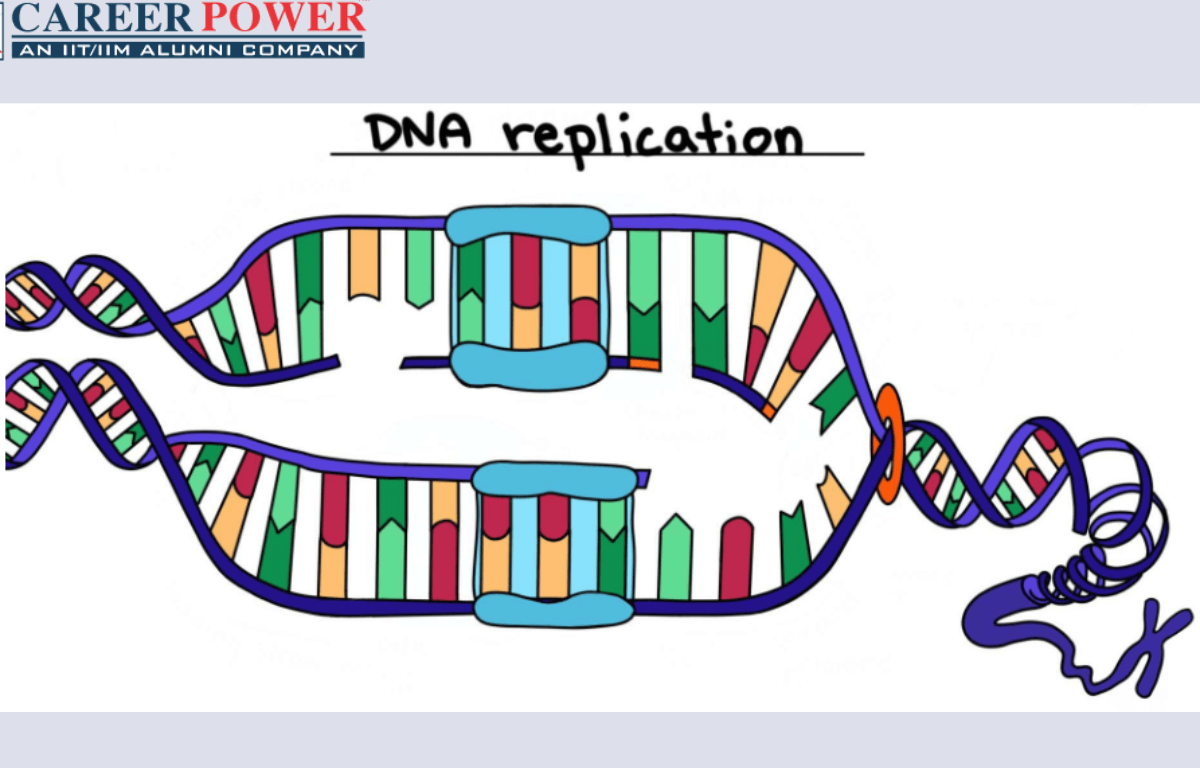As we know both DNA and RNA are two very important topics not just for class 10th or 12th students but also for students who are preparing for the NEET examination in Biology. DNA replication is the process by which an exact copy of its DNA. It starts by unzipping the DNA double helix, using enzymes like helicase and primase. Then, DNA polymerase adds new matching building blocks (nucleotides) to each side, creating two identical DNA strands. This ensures that each new cell gets a complete set of genetic instructions.
What is DNA Replication?
DNA replication is the biological process by which a cell makes an exact copy of its DNA, which is essential for cell division and inheritance of genetic information. It occurs in the nucleus of the Eukaryotic cells and cytoplasm of the Prokaryotic cells and involves the separation of the DNA double helix, followed by the synthesis of complementary strands using existing DNA as a template. This process ensures that each daughter cell receives an identical set of genetic information to the parent cell during cell division.

Process of DNA Replication
As we know DNA replication is a complex process that ensures the accurate duplication of an organism’s genetic material. Now let us take an overview of the process of DNA Replication.

DNA Replication is a precisely orchestrated cellular process where the double-stranded DNA molecule unwinds at specific sites called origins of replication. Enzymes, like helicase and DNA polymerase, work in concert to duplicate the DNA by synthesizing complementary strands. The leading strand is synthesized continuously, while the lagging strand is formed in short fragments. RNA primers are replaced with DNA, and these fragments are connected by the DNA ligase. This process results in two identical DNA molecules, crucial for genetic continuity in cells and organisms.

In simple terms, DNA replication is like making a copy of a book. First, the book’s pages are carefully opened, then copies of each page are made. One copy follows the book from start to finish (like the leading strand), while another copy jumps around and needs sticky notes (like the lagging strand). Once all the pages are copied and the sticky notes are turned into the real text, you have two identical books – just like how cells duplicate their DNA for growth and reproduction.
Steps Involved In DNA Replication
DNA Replication is a highly coordinated and intricate process that ensures the accurate duplication of a cell’s genetic information. This process ensures the faithful transmission of genetic information from one generation of cells to the next and is essential for the growth, development, and maintenance of living organisms. Here are the steps involved in DNA replication:
| Steps Involved In the Process of DNA Replication | |
| Steps | Description |
| Initiation | Initiation begins at the origins of replication with helicase unwinding the DNA. |
| DNA Unwinding | Single-strand binding proteins keep the DNA strands apart. |
| Primer Synthesis | Primase creates RNA primers as starting points. |
| DNA Synthesis | DNA polymerases add nucleotides to form new strands. |
| Leading and Lagging Strands | DNA polymerases add nucleotides to form new strands. |
| Okazaki Fragment Processing | The leading strand is made continuously; the lagging strand in Okazaki fragments. |
| Termination | RNA primers are replaced with DNA, and fragments are joined by DNA ligase. |
| Proofreading and Repair | DNA polymerases correct errors, and repair mechanisms fix the damage. |
| End Result | Two identical DNA molecules with one old and one new strand. |
Step1: Initiation
- DNA replication begins at specific sites on the DNA molecules called Origins of replication.
- In prokaryotes, there is a single origin of replication, while eukaryotic cells have multiple origins.
- Enzymes called Helicases unwind and separate the double-stranded DNA at these origins, creating a replication bubble.
Step2: DNA Unwinding
As the double helix unwinds, single-strand binding proteins bind to the separated DNA strands, preventing them from reannealing.
Step3: Primer Synthesis
- DNA cannot be synthesized from scratch; it requires a starting point.
- Primase synthesizes a short RNA primer complementary to the DNA template strand. This primer provides a 3′-OH group for DNA polymerases to add nucleotides.
Step4: DNA Synthesis
- DNA polymerases catalyze the addition of nucleotides to the growing DNA strand.
- The leading strand is synthesized continuously in the 5′ to 3′ direction because its template strand runs 3′ to 5′.
- The lagging strand is synthesized discontinuously in short fragments called Okazaki fragments because its template strand runs 5′ to 3′.
- In prokaryotic cells, DNA polymerase III synthesizes most of the new DNA, while DNA polymerase I removes RNA primers and replaces them with DNA.
- In eukaryotes, DNA polymerase δ and ε play similar roles.
Step5: Okazaki Fragment Processing
- RNA primers in Okazaki fragments are replaced with DNA nucleotides by DNA polymerase.
- The enzyme DNA ligase joins them together, creating a continuous strand.
Step6: Termination
- DNA replication continues bidirectionally until it reaches termination sites, which vary depending on the organism.
- In prokaryotes, termination involves specific protein-binding sites.
- In eukaryotes, telomeres at the ends of chromosomes pose challenges and require specialized mechanisms for replication.
Step7: Proofreading and Repair
- DNA polymerases have proofreading capabilities to detect and correct errors in nucleotide incorporation, ensuring high-fidelity replication.
- DNA repair mechanisms continuously monitor and fix any damage or mismatches in the newly synthesized DNA.
Step8: End Result
The end result of DNA replication is two identical double-stranded DNA molecules, each consisting of one original (parental) strand and one newly synthesized (daughter) strand.
This whole process of DNA replication ensures the faithful transmission of genetic information from one generation of cells to the next and is essential for the growth, development, and maintenance of living organisms.
Enzymes Involved in the Process of DNA Replication
DNA Replication is a complex process that involves several enzymes working together to ensure the accurate duplication of genetic material. These enzymes work together in a highly coordinated manner to ensure the accurate and faithful replication of DNA. The combination of unwinding, priming, synthesizing, proofreading, and sealing processes helps maintain the integrity of the genetic information. Here are some of the key enzymes involved in DNA replication:
| Enzymes Involved in the Process of DNA Replication | |
| Enzymes Involved | Function |
| Helicase | Unwinds the double-stranded DNA, creating a replication fork. |
| Topoisomerase | Relieves tension ahead of the replication fork by making and resealing temporary cuts in DNA. |
| Single-Strand Blinding Proteins (SSBs) | Binds to single-stranded DNA to prevent reannealing and stabilize the strands. |
| Primase | Synthesizes RNA primers complementary to the template DNA strand. |
| DNA Polymerase III | Main enzyme for synthesizing the new DNA strand in a 5′ to 3′ direction. |
| DNA Polymerase I | Removes RNA primers and replaces them with DNA; has a proofreading function. |
| Ligase | Seals nicks or gaps in the DNA by forming phosphodiester bonds. |
| Exonuclease | Removes incorrect nucleotides from the newly synthesized DNA strand; proofreading activity. |
| DNA Polymerase II and IV | Involved in DNA repair, can fix damaged DNA during replication or in response to environmental factors. |
| DNA Ligase I | Seals nicks in the DNA during the final stages of replication and DNA repair. |
| Endonuclease | Removes damaged or mismatched DNA segments during DNA repair. |
- Helicase: Helicase is responsible for unwinding the double-stranded DNA molecule. It separates the two strands by breaking the hydrogen bonds between complementary base pairs, creating a replication fork.
- Topoisomerase: DNA unwinding creates tension ahead of the replication fork. Topoisomerase helps relieve this tension by making temporary cuts in the DNA strands and then resealing them. This prevents the DNA from becoming overly twisted.
- Single-Strand Binding Proteins (SSBs): These proteins bind to the single-stranded DNA exposed during replication and prevent the strands from reannealing or forming secondary structures. This keeps the DNA in a suitable state for replication.
- Primase: Primase synthesizes short RNA primers complementary to the template DNA strand. These primers provide a starting point for DNA polymerases to begin synthesizing new DNA strands.
- DNA Polymerase III: DNA Polymerase III is the main enzyme responsible for elongating the newly synthesized DNA strand during replication. It can add nucleotides to the 3′ end of a growing DNA strand in a 5′ to 3′ direction.
- DNA Polymerase I: DNA Polymerase I plays a role in removing the RNA primers and replacing them with DNA. It also has a proofreading function, helping to correct any errors in the newly synthesized DNA.
- Ligase: Ligase seals the nicks or gaps between the Okazaki fragments on the lagging strand by catalyzing the formation of phosphodiester bonds, creating a continuous, double-stranded DNA molecule.
- Exonuclease: These enzymes are responsible for removing incorrect nucleotides that may have been incorporated into the newly synthesized DNA strand. DNA Polymerase III has a 3′ to 5′ exonuclease proofreading activity to correct errors.
- DNA Polymerase II and IV: These enzymes are involved in DNA repair and can help fix damaged DNA during replication or in response to environmental factors.
- DNA Ligase I: This enzyme plays a role in sealing nicks in the DNA during the final stages of replication and DNA repair.
- Endonuclease: Certain endonucleases are involved in the removal of damaged or mismatched DNA segments during DNA repair.
DNA Replication in different organisms
DNA replication is a fundamental process that occurs in all living organisms such as prokaryotes (bacteria) and eukaryotes (like plants and animals), but there can be variation in the details of this process among different types of organisms. Here’s a brief overview of DNA replication in various types of organisms.
DNA Replication in Prokaryotes
- Prokaryotic DNA is typically a single, circular molecule located in the nucleoid region of the cell.
- Bacteria have a single origin of replication (OriC) where replication begins.
- Helicase enzymes unwind the double-stranded DNA at the origin, creating an application bubble.
- Primase synthesizes a short RNA primer complementary to the DNA template, providing a starting point for DNA synthesis.
- DNA polymerase III is the primary enzyme responsible for DNA synthesis.
- DNA polymerase I replaces RNA primers with DNA and has a proofreading function.
- Replication terminates when the two forks meet on the opposite side of the circular DNA molecules.
- DNA ligase seals the nicks or gaps in the new DNA strand, forming a continuous circular DNA molecule.
DNA Replication in Eukaryotes
- Eukaryotic DNA is linear and exists within the cell nucleus.
- Multiple origins of replication are present along each chromosome.
- DNA replication in eukaryotes is more complex and involves various various checkpoints and regulatory mechanisms.
- Replication occurs within the nucleus, and DNA must be packaged into chromatin structures.



 50 Vegetables Name for Kids in English a...
50 Vegetables Name for Kids in English a...
 Food Chain: Definition, Types, Examples,...
Food Chain: Definition, Types, Examples,...
 Human Respiratory System: Definition, Di...
Human Respiratory System: Definition, Di...













